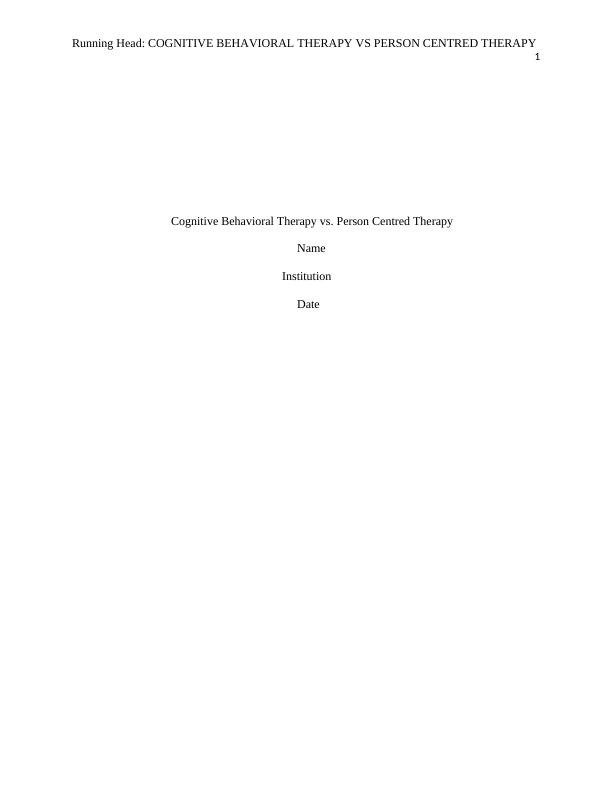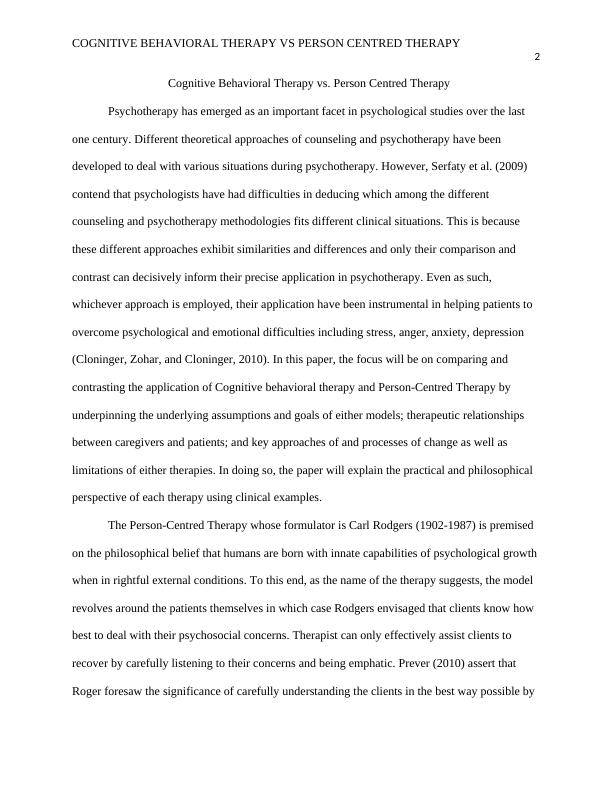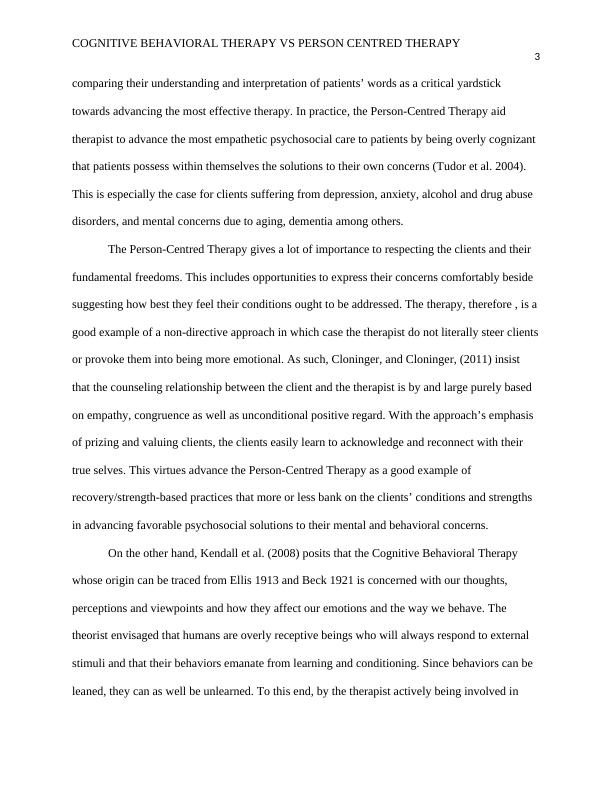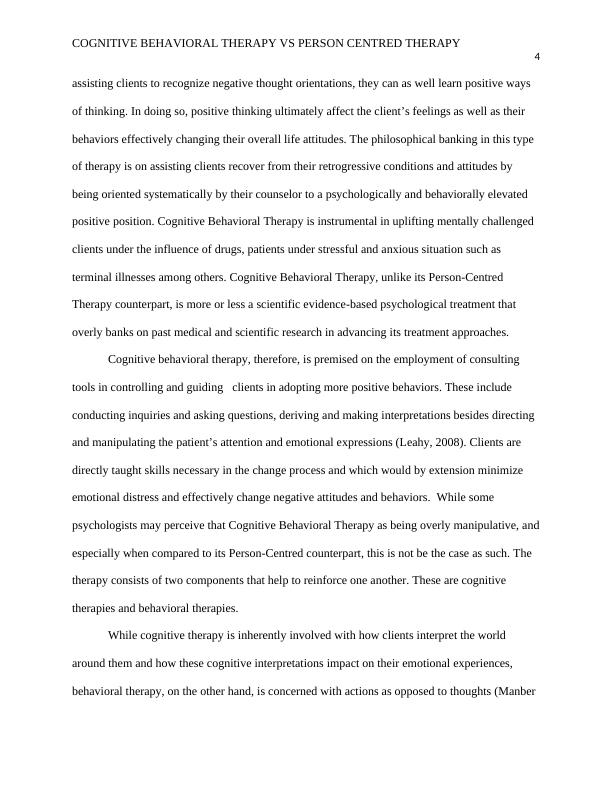Cognitive Behavioral Therapy vs. Person Centred Therapy
Added on 2023-06-10
13 Pages3761 Words346 Views
Running Head: COGNITIVE BEHAVIORAL THERAPY VS PERSON CENTRED THERAPY
1
Cognitive Behavioral Therapy vs. Person Centred Therapy
Name
Institution
Date
1
Cognitive Behavioral Therapy vs. Person Centred Therapy
Name
Institution
Date

COGNITIVE BEHAVIORAL THERAPY VS PERSON CENTRED THERAPY
2
Cognitive Behavioral Therapy vs. Person Centred Therapy
Psychotherapy has emerged as an important facet in psychological studies over the last
one century. Different theoretical approaches of counseling and psychotherapy have been
developed to deal with various situations during psychotherapy. However, Serfaty et al. (2009)
contend that psychologists have had difficulties in deducing which among the different
counseling and psychotherapy methodologies fits different clinical situations. This is because
these different approaches exhibit similarities and differences and only their comparison and
contrast can decisively inform their precise application in psychotherapy. Even as such,
whichever approach is employed, their application have been instrumental in helping patients to
overcome psychological and emotional difficulties including stress, anger, anxiety, depression
(Cloninger, Zohar, and Cloninger, 2010). In this paper, the focus will be on comparing and
contrasting the application of Cognitive behavioral therapy and Person-Centred Therapy by
underpinning the underlying assumptions and goals of either models; therapeutic relationships
between caregivers and patients; and key approaches of and processes of change as well as
limitations of either therapies. In doing so, the paper will explain the practical and philosophical
perspective of each therapy using clinical examples.
The Person-Centred Therapy whose formulator is Carl Rodgers (1902-1987) is premised
on the philosophical belief that humans are born with innate capabilities of psychological growth
when in rightful external conditions. To this end, as the name of the therapy suggests, the model
revolves around the patients themselves in which case Rodgers envisaged that clients know how
best to deal with their psychosocial concerns. Therapist can only effectively assist clients to
recover by carefully listening to their concerns and being emphatic. Prever (2010) assert that
Roger foresaw the significance of carefully understanding the clients in the best way possible by
2
Cognitive Behavioral Therapy vs. Person Centred Therapy
Psychotherapy has emerged as an important facet in psychological studies over the last
one century. Different theoretical approaches of counseling and psychotherapy have been
developed to deal with various situations during psychotherapy. However, Serfaty et al. (2009)
contend that psychologists have had difficulties in deducing which among the different
counseling and psychotherapy methodologies fits different clinical situations. This is because
these different approaches exhibit similarities and differences and only their comparison and
contrast can decisively inform their precise application in psychotherapy. Even as such,
whichever approach is employed, their application have been instrumental in helping patients to
overcome psychological and emotional difficulties including stress, anger, anxiety, depression
(Cloninger, Zohar, and Cloninger, 2010). In this paper, the focus will be on comparing and
contrasting the application of Cognitive behavioral therapy and Person-Centred Therapy by
underpinning the underlying assumptions and goals of either models; therapeutic relationships
between caregivers and patients; and key approaches of and processes of change as well as
limitations of either therapies. In doing so, the paper will explain the practical and philosophical
perspective of each therapy using clinical examples.
The Person-Centred Therapy whose formulator is Carl Rodgers (1902-1987) is premised
on the philosophical belief that humans are born with innate capabilities of psychological growth
when in rightful external conditions. To this end, as the name of the therapy suggests, the model
revolves around the patients themselves in which case Rodgers envisaged that clients know how
best to deal with their psychosocial concerns. Therapist can only effectively assist clients to
recover by carefully listening to their concerns and being emphatic. Prever (2010) assert that
Roger foresaw the significance of carefully understanding the clients in the best way possible by

COGNITIVE BEHAVIORAL THERAPY VS PERSON CENTRED THERAPY
3
comparing their understanding and interpretation of patients’ words as a critical yardstick
towards advancing the most effective therapy. In practice, the Person-Centred Therapy aid
therapist to advance the most empathetic psychosocial care to patients by being overly cognizant
that patients possess within themselves the solutions to their own concerns (Tudor et al. 2004).
This is especially the case for clients suffering from depression, anxiety, alcohol and drug abuse
disorders, and mental concerns due to aging, dementia among others.
The Person-Centred Therapy gives a lot of importance to respecting the clients and their
fundamental freedoms. This includes opportunities to express their concerns comfortably beside
suggesting how best they feel their conditions ought to be addressed. The therapy, therefore , is a
good example of a non-directive approach in which case the therapist do not literally steer clients
or provoke them into being more emotional. As such, Cloninger, and Cloninger, (2011) insist
that the counseling relationship between the client and the therapist is by and large purely based
on empathy, congruence as well as unconditional positive regard. With the approach’s emphasis
of prizing and valuing clients, the clients easily learn to acknowledge and reconnect with their
true selves. This virtues advance the Person-Centred Therapy as a good example of
recovery/strength-based practices that more or less bank on the clients’ conditions and strengths
in advancing favorable psychosocial solutions to their mental and behavioral concerns.
On the other hand, Kendall et al. (2008) posits that the Cognitive Behavioral Therapy
whose origin can be traced from Ellis 1913 and Beck 1921 is concerned with our thoughts,
perceptions and viewpoints and how they affect our emotions and the way we behave. The
theorist envisaged that humans are overly receptive beings who will always respond to external
stimuli and that their behaviors emanate from learning and conditioning. Since behaviors can be
leaned, they can as well be unlearned. To this end, by the therapist actively being involved in
3
comparing their understanding and interpretation of patients’ words as a critical yardstick
towards advancing the most effective therapy. In practice, the Person-Centred Therapy aid
therapist to advance the most empathetic psychosocial care to patients by being overly cognizant
that patients possess within themselves the solutions to their own concerns (Tudor et al. 2004).
This is especially the case for clients suffering from depression, anxiety, alcohol and drug abuse
disorders, and mental concerns due to aging, dementia among others.
The Person-Centred Therapy gives a lot of importance to respecting the clients and their
fundamental freedoms. This includes opportunities to express their concerns comfortably beside
suggesting how best they feel their conditions ought to be addressed. The therapy, therefore , is a
good example of a non-directive approach in which case the therapist do not literally steer clients
or provoke them into being more emotional. As such, Cloninger, and Cloninger, (2011) insist
that the counseling relationship between the client and the therapist is by and large purely based
on empathy, congruence as well as unconditional positive regard. With the approach’s emphasis
of prizing and valuing clients, the clients easily learn to acknowledge and reconnect with their
true selves. This virtues advance the Person-Centred Therapy as a good example of
recovery/strength-based practices that more or less bank on the clients’ conditions and strengths
in advancing favorable psychosocial solutions to their mental and behavioral concerns.
On the other hand, Kendall et al. (2008) posits that the Cognitive Behavioral Therapy
whose origin can be traced from Ellis 1913 and Beck 1921 is concerned with our thoughts,
perceptions and viewpoints and how they affect our emotions and the way we behave. The
theorist envisaged that humans are overly receptive beings who will always respond to external
stimuli and that their behaviors emanate from learning and conditioning. Since behaviors can be
leaned, they can as well be unlearned. To this end, by the therapist actively being involved in

COGNITIVE BEHAVIORAL THERAPY VS PERSON CENTRED THERAPY
4
assisting clients to recognize negative thought orientations, they can as well learn positive ways
of thinking. In doing so, positive thinking ultimately affect the client’s feelings as well as their
behaviors effectively changing their overall life attitudes. The philosophical banking in this type
of therapy is on assisting clients recover from their retrogressive conditions and attitudes by
being oriented systematically by their counselor to a psychologically and behaviorally elevated
positive position. Cognitive Behavioral Therapy is instrumental in uplifting mentally challenged
clients under the influence of drugs, patients under stressful and anxious situation such as
terminal illnesses among others. Cognitive Behavioral Therapy, unlike its Person-Centred
Therapy counterpart, is more or less a scientific evidence-based psychological treatment that
overly banks on past medical and scientific research in advancing its treatment approaches.
Cognitive behavioral therapy, therefore, is premised on the employment of consulting
tools in controlling and guiding clients in adopting more positive behaviors. These include
conducting inquiries and asking questions, deriving and making interpretations besides directing
and manipulating the patient’s attention and emotional expressions (Leahy, 2008). Clients are
directly taught skills necessary in the change process and which would by extension minimize
emotional distress and effectively change negative attitudes and behaviors. While some
psychologists may perceive that Cognitive Behavioral Therapy as being overly manipulative, and
especially when compared to its Person-Centred counterpart, this is not be the case as such. The
therapy consists of two components that help to reinforce one another. These are cognitive
therapies and behavioral therapies.
While cognitive therapy is inherently involved with how clients interpret the world
around them and how these cognitive interpretations impact on their emotional experiences,
behavioral therapy, on the other hand, is concerned with actions as opposed to thoughts (Manber
4
assisting clients to recognize negative thought orientations, they can as well learn positive ways
of thinking. In doing so, positive thinking ultimately affect the client’s feelings as well as their
behaviors effectively changing their overall life attitudes. The philosophical banking in this type
of therapy is on assisting clients recover from their retrogressive conditions and attitudes by
being oriented systematically by their counselor to a psychologically and behaviorally elevated
positive position. Cognitive Behavioral Therapy is instrumental in uplifting mentally challenged
clients under the influence of drugs, patients under stressful and anxious situation such as
terminal illnesses among others. Cognitive Behavioral Therapy, unlike its Person-Centred
Therapy counterpart, is more or less a scientific evidence-based psychological treatment that
overly banks on past medical and scientific research in advancing its treatment approaches.
Cognitive behavioral therapy, therefore, is premised on the employment of consulting
tools in controlling and guiding clients in adopting more positive behaviors. These include
conducting inquiries and asking questions, deriving and making interpretations besides directing
and manipulating the patient’s attention and emotional expressions (Leahy, 2008). Clients are
directly taught skills necessary in the change process and which would by extension minimize
emotional distress and effectively change negative attitudes and behaviors. While some
psychologists may perceive that Cognitive Behavioral Therapy as being overly manipulative, and
especially when compared to its Person-Centred counterpart, this is not be the case as such. The
therapy consists of two components that help to reinforce one another. These are cognitive
therapies and behavioral therapies.
While cognitive therapy is inherently involved with how clients interpret the world
around them and how these cognitive interpretations impact on their emotional experiences,
behavioral therapy, on the other hand, is concerned with actions as opposed to thoughts (Manber

End of preview
Want to access all the pages? Upload your documents or become a member.
Related Documents
Cognitive Behavioural Therapy vs Computer-assisted Therapylg...
|7
|1591
|131
Comparison of Person Centred, Transactional and Existential Therapies in Counsellinglg...
|7
|2016
|380
Psychotherapies for Marijuana Use Disorder and Anxiety: CBT and Family Therapieslg...
|11
|3229
|467
Assessment and Counseling of a Hypothetical Client with Eating Disorder using Cognitive Behavioral Therapylg...
|8
|1953
|482
Elements of Ethical Psychology: Comparing Major Approaches to Clinical Psychology in Treating Depressive Disorderlg...
|10
|1019
|212
Treatments and Therapies for Mental Health: Psychodynamic, Somatic, and Behavioural Approacheslg...
|2
|1284
|238
